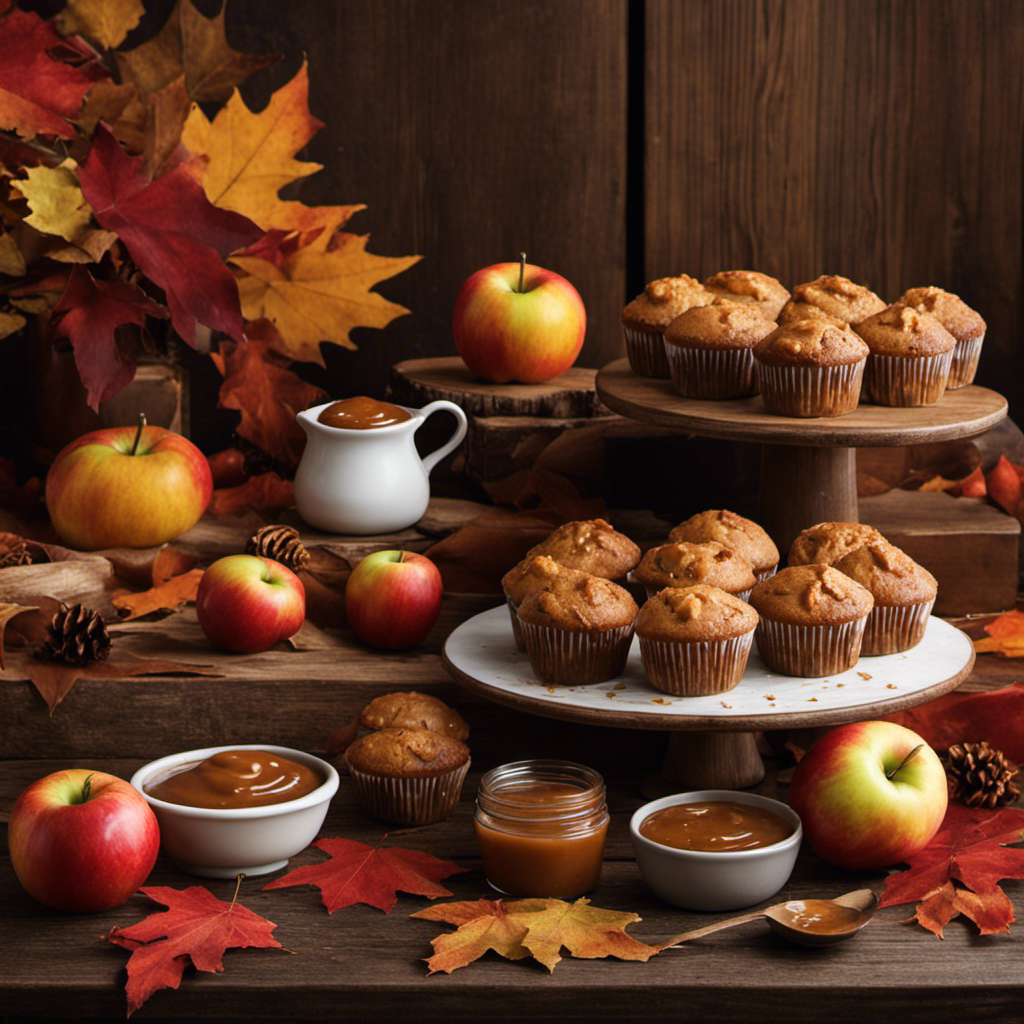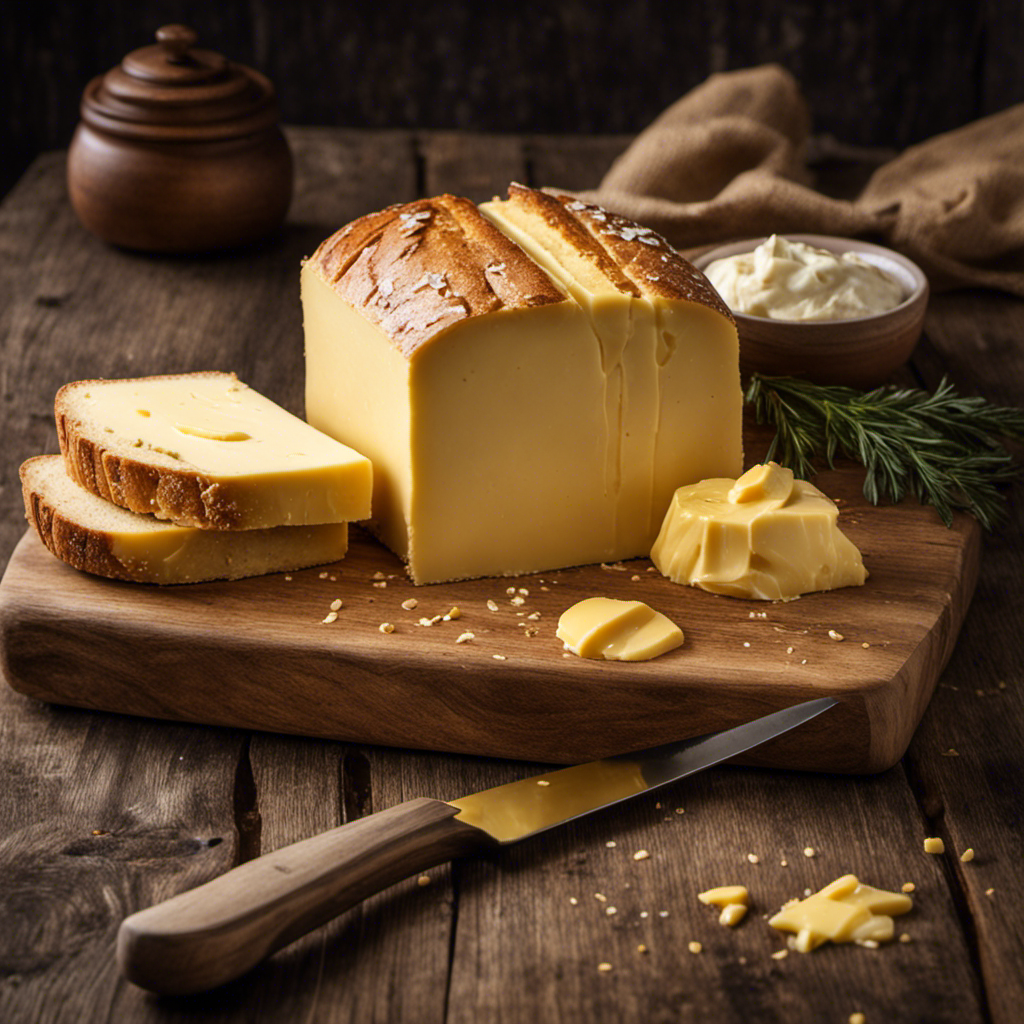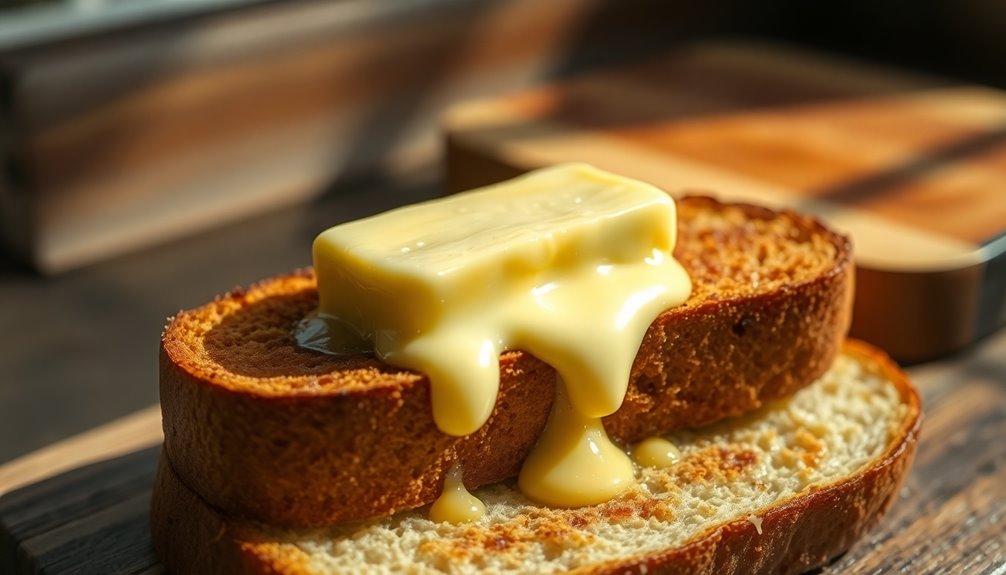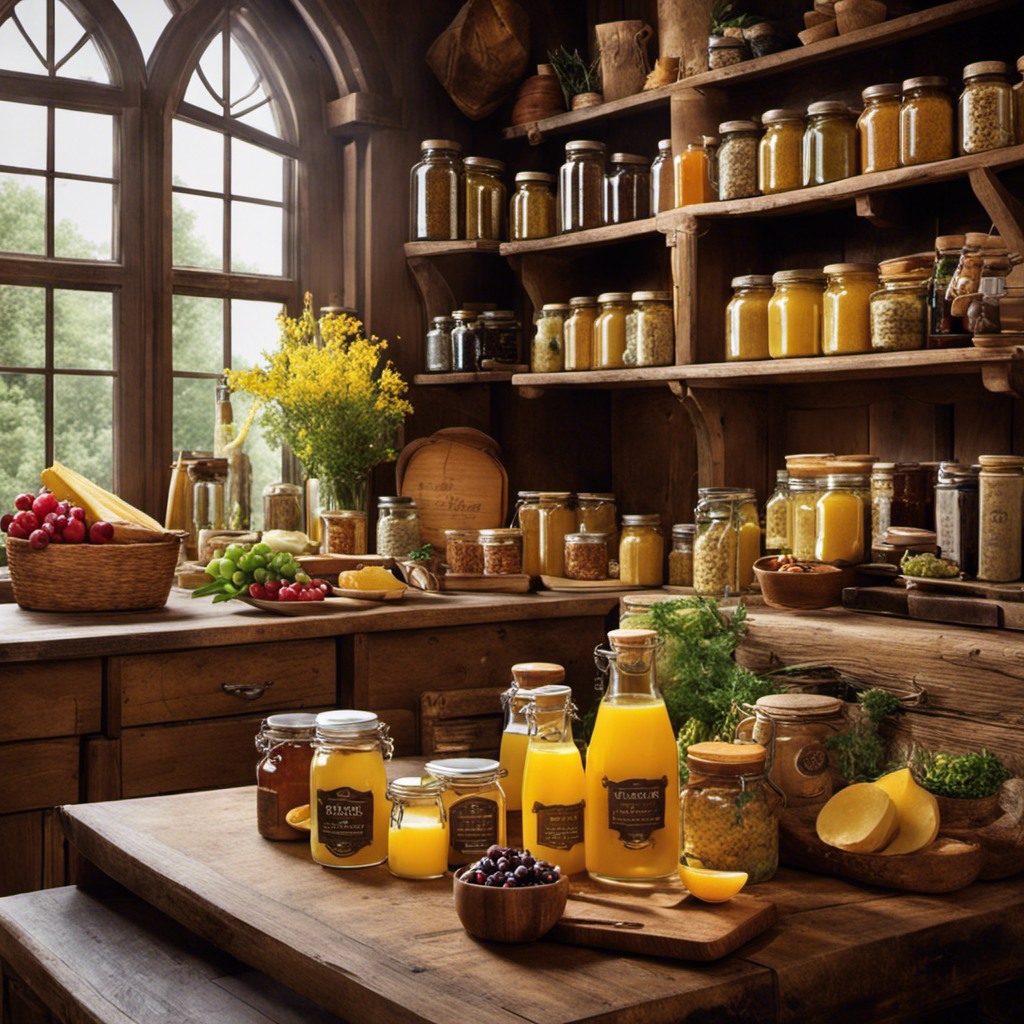Did you know that apple butter can be a versatile ingredient that can elevate a variety of dishes?
From sweet treats to savory dishes, breakfast ideas to baked goods, there are so many delicious ways to incorporate apple butter into your cooking.
In this article, I will share some creative and unexpected ways to make the most out of this delightful spread.
Get ready to tantalize your taste buds and discover new culinary adventures with apple butter!
Key Takeaways
- Apple butter can be used in both sweet and savory dishes, adding a rich and fruity flavor.
- It pairs well with baked goods such as toast, biscuits, cookies, and cakes.
- In savory dishes, it can be used in grilled cheese sandwiches, soups, and as a marinade for meat.
- Apple butter can also be used as a condiment or spread on toast, sandwiches, oatmeal, and yogurt.
Sweet Treats With Apple Butter
There are so many delicious treats you can make with apple butter! One of my favorite ways to enjoy this sweet and tangy spread is by incorporating it into dessert recipes. Apple butter pairs perfectly with a variety of baked goods, adding a rich and fruity flavor.
For a simple yet satisfying treat, try spreading apple butter on warm toast or biscuits. The combination of the buttery bread and the sweet apple flavor is simply divine.
Another delightful option is apple butter cookies. The apple butter adds moisture and depth to the cookies, making them chewy and irresistible.
And let’s not forget about apple butter cake. This moist and flavorful dessert is enhanced by the addition of apple butter, giving it a subtle fruity taste that is sure to please.
With apple butter as your secret ingredient, the possibilities for sweet treats are endless!
Savory Dishes to Try With Apple Butter
One delicious idea is to spread apple butter on a grilled cheese sandwich for a savory twist. The tangy sweetness of the apple butter pairs perfectly with the melted cheese, creating a mouthwatering combination.
But did you know that apple butter can also be used in soups and as a marinade? When added to soups, apple butter adds depth and richness to the flavors. It brings a touch of sweetness that balances out the savory elements, creating a harmonious taste.
As a marinade, apple butter tenderizes the meat while infusing it with a hint of sweetness and tanginess. Whether you’re making a hearty vegetable soup or marinating chicken for the grill, apple butter is a versatile ingredient that adds a unique twist to your savory dishes.
Breakfast Ideas Using Apple Butter
Adding apple butter to a stack of warm pancakes creates a deliciously sweet and tangy flavor combination. The smooth texture of the apple butter perfectly complements the fluffy pancakes, making each bite a delightful experience.
As the apple butter melts into the pancakes, it infuses them with a rich, fruity taste that is simply irresistible.
For a twist on the classic breakfast sandwich, spread a generous amount of apple butter onto a toasted English muffin and layer it with crispy bacon and a fried egg. The sweetness of the apple butter cuts through the savory flavors, creating a harmonious blend of tastes.
Whether you’re enjoying apple butter pancakes or a breakfast sandwich, the addition of apple butter adds a burst of flavor that will elevate your breakfast to a whole new level.
Apple Butter as a Condiment or Spread
Using apple butter as a spread on toast or as a condiment on a sandwich adds a delightful burst of sweet and tangy flavor. The smooth texture and rich taste of apple butter perfectly complement a variety of dishes.
Here are three ways to enjoy apple butter:
-
Spread apple butter on warm, buttered toast for a comforting breakfast or snack. The combination of the warm bread and the sweet apple butter is a match made in heaven.
-
Use apple butter as a condiment on a turkey or ham sandwich. The tangy sweetness of the apple butter pairs wonderfully with the savory meats, giving your sandwich an extra punch of flavor.
-
Mix apple butter into your oatmeal or yogurt for a delicious twist. The natural sweetness of the apple butter adds depth to your breakfast, making it even more enjoyable.
With these apple butter recipes and uses, you can elevate your meals with a burst of fruity goodness.
Apple Butter in Baked Goods
To enhance your baked goods, try incorporating apple butter for a moist and flavorful twist.
Apple butter is a versatile ingredient that can be used in various baked treats, such as pies and muffins.
When used in pies, apple butter adds a depth of flavor and a hint of sweetness to the filling. It pairs perfectly with tart apples, creating a harmonious balance of flavors. The result is a pie that is rich, aromatic, and irresistible.
In muffins, apple butter adds moisture and tenderness to the batter. It also imparts a subtle apple flavor that complements other ingredients like cinnamon or nutmeg. The end product is a batch of muffins that are soft, moist, and bursting with flavor.
Unexpected Ways to Use Apple Butter in Your Cooking
When it comes to apple butter, the possibilities are endless. Whether you prefer something sweet or savory, there are plenty of options to explore.
From delicious breakfast dishes to unique dessert ideas, apple butter can be a versatile ingredient that adds a burst of flavor to your cooking.
Sweet or Savory
Whether you’re in the mood for something sweet or savory, there are endless possibilities for what you can create with apple butter. This versatile spread can be used in both sweet and spicy dishes to add a unique twist to your meals.
Here are three main course options that you can make with apple butter:
-
Grilled Apple Butter Chicken: Marinate chicken breasts in a mixture of apple butter, soy sauce, garlic, and spices, then grill them to perfection. The sweet and tangy flavors of the apple butter complement the juicy chicken, creating a delicious and satisfying dish.
-
Apple Butter Glazed Pork Chops: Coat pork chops with a mixture of apple butter, Dijon mustard, and brown sugar, then bake them until they are tender and caramelized. The combination of the savory pork and the sweet apple butter glaze is simply irresistible.
-
Spicy Apple Butter Meatballs: Mix ground meat with breadcrumbs, egg, onion, garlic, and spices, then shape them into meatballs. Cook the meatballs in a sauce made from apple butter, tomato sauce, and red pepper flakes for a spicy kick. The apple butter adds a touch of sweetness that balances out the heat of the spices.
These main course options showcase the versatility of apple butter and how it can elevate your dishes from ordinary to extraordinary. So whether you prefer sweet or spicy, give apple butter a try and discover a whole new world of flavors.
Breakfast Options
If you’re craving a delicious and unique breakfast, there are endless possibilities for incorporating apple butter into your morning meal. One option is to make apple butter pancakes. Imagine fluffy pancakes with a subtle hint of sweetness from the apple butter, topped with a dollop of whipped cream and a drizzle of maple syrup. It’s the perfect combination of flavors to start your day off right.
Another tasty idea is apple butter oatmeal. Simply stir a spoonful of apple butter into your bowl of warm, creamy oatmeal, and watch as the flavors meld together to create a comforting and satisfying breakfast. These breakfast options are not only delicious but also incredibly easy to make. So why not give them a try and start your day with a burst of apple butter goodness?
Speaking of goodness, did you know that apple butter can also be used to create unique dessert ideas?
Unique Dessert Ideas?
Why not try incorporating apple butter into your desserts for a unique and delicious twist? Apple butter is a versatile ingredient that adds a rich, sweet flavor to any dessert.
Here are three creative ways to use apple butter in your desserts:
-
Apple Butter Cheesecake Bars: The creamy and tangy flavor of cheesecake pairs perfectly with the smooth sweetness of apple butter. Swirl apple butter into the cheesecake batter and bake it on top of a buttery graham cracker crust for a heavenly treat.
-
Apple Butter Bread Pudding: Transform stale bread into a decadent dessert by soaking it in a mixture of milk, eggs, sugar, and apple butter. Bake until golden and serve warm with a drizzle of caramel sauce for a comforting and indulgent dessert.
-
Apple Butter Ice Cream: Add a spoonful of apple butter to your favorite homemade ice cream base. The apple butter will create a swirl of flavor throughout the ice cream, giving it a unique and delicious taste.
These creative apple butter recipes will elevate your desserts to a whole new level of deliciousness. And if you’re feeling adventurous, try incorporating apple butter into your cocktails for a tasty twist. Cheers!
Frequently Asked Questions
Can I Make My Own Apple Butter at Home?
Yes, I can make my own apple butter at home. It’s a delicious spread made by simmering apples and spices. I can even make it without sugar! Plus, there are so many different ways to use apple butter in recipes.
How Long Does Apple Butter Last in the Refrigerator?
Apple butter can last in the refrigerator for up to 2 months. It’s versatile and can be used in various recipes, like apple butter muffins, apple butter pancakes, or even as a topping for toast.
Can I Substitute Apple Butter for Applesauce in Recipes?
Yes, you can substitute apple butter for applesauce in recipes. It adds a rich, caramelized flavor and a slightly thicker texture. Try using it in baking to enhance the taste of your favorite treats.
Can I Freeze Apple Butter for Later Use?
Yes, you can freeze apple butter for later use. Simply transfer it to a freezer-safe container, leaving some space for expansion. When you’re ready to use it, thaw it in the refrigerator overnight. Enjoy the deliciousness!
Is Apple Butter Gluten-Free?
Yes, apple butter is gluten-free! It’s a versatile ingredient that can be used in various recipes. From spreading it on toast to adding it to baked goods, the possibilities are endless. Plus, apple butter is packed with health benefits too!
Conclusion
In conclusion, apple butter is a versatile ingredient that can elevate any dish with its rich, sweet flavor. Whether you’re looking to satisfy your sweet tooth or add a touch of sweetness to your savory meals, apple butter has got you covered.
From delectable desserts to mouthwatering breakfast ideas, there are endless possibilities when it comes to using apple butter in your cooking.
And here’s an interesting statistic: did you know that apple butter is fat-free and low in calories? So you can indulge guilt-free!
So go ahead, get creative and explore the delicious world of apple butter in your kitchen.










